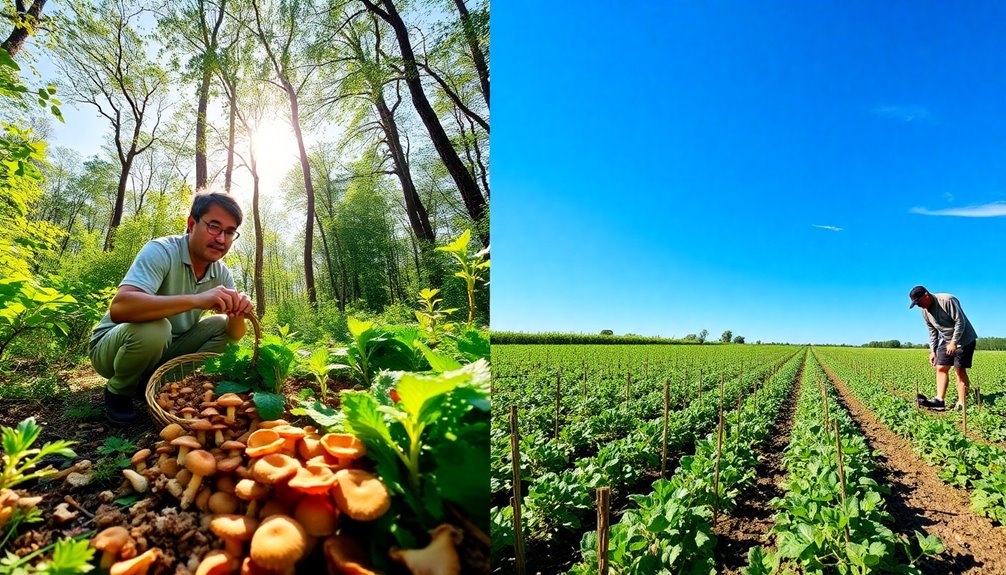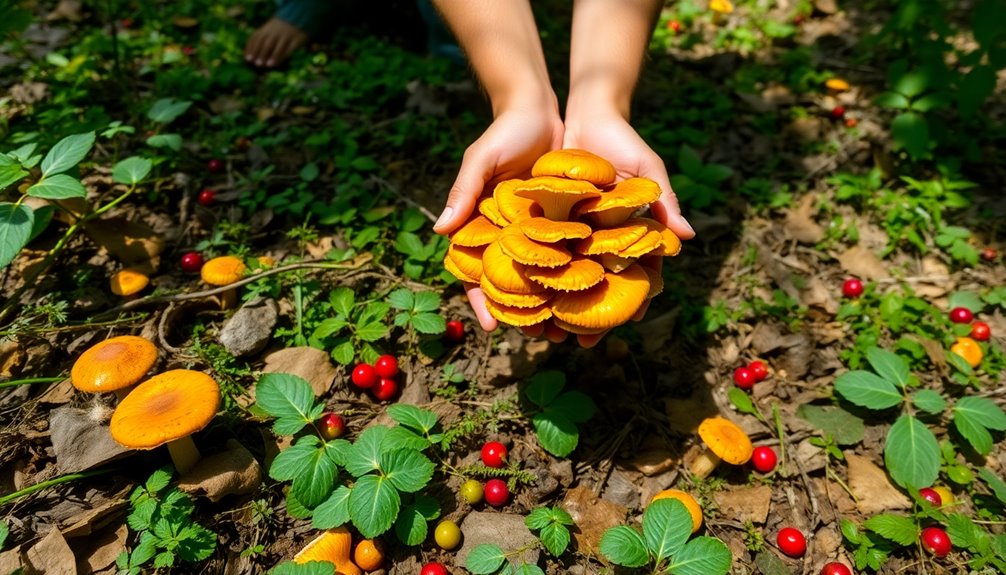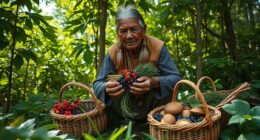Farming and foraging each offered unique benefits and drawbacks that shaped ancient societies. While farming provided a stable food supply and propelled population growth, it also led to social inequality and health issues due to sedentary lifestyles. On the other hand, foraging encouraged diverse diets, promoting better health and social equality. Foragers had lower disease rates and a lesser environmental impact. The debate over which practice is superior stems from these differing outcomes. Curious about how these practices influenced culture and society? You'll uncover fascinating insights that reveal the complexity behind this historical shift.
Key Takeaways
- Farming provided a stable food supply, enabling population growth and the development of complex societies, unlike the more variable yields of foraging.
- Foraging promoted a diverse diet, leading to healthier populations with lower disease prevalence compared to early agricultural societies.
- Farming led to social stratification and economic disparities, while foraging communities generally maintained greater social equality through resource sharing.
- Agricultural practices increased environmental impact through soil depletion and reliance on monocultures, contrasting with the sustainable lifestyles of foragers.
- The shift from foraging to farming fostered specialized labor roles, enhancing productivity but also creating entrenched social hierarchies in agricultural societies.
Historical Context of Foraging
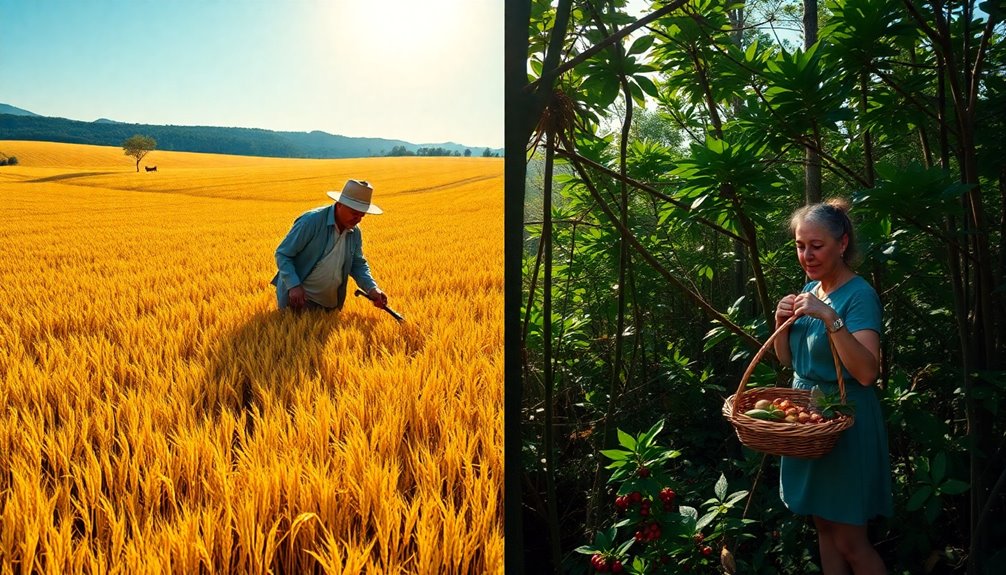
Foraging has shaped human survival for tens of thousands of years, rooted in a sustainable lifestyle that adapts to the changing environment.
Foraging societies, relying on hunting and gathering, developed diverse diets rich in nutrients, often leading to healthier populations. Archaeological evidence shows that these communities maintained lower instances of diseases compared to those who shifted to farming.
In foraging communities, social equality thrived. People worked cooperatively, sharing resources and responsibilities, which fostered a sense of community. This contrasts sharply with the social hierarchies that emerged in agricultural societies, where property ownership created divisions among individuals.
Modern foraging societies, like the San people of Southern Africa, provide valuable insights into these ancient lifestyles. They exemplify communal living, emphasizing community engagement and the sharing of resources, traits that have persisted through time.
The shift to farming wasn't abrupt; it varied by region and often coexisted with traditional foraging methods. Many groups continued their foraging practices even as agriculture began to take hold.
Understanding the historical context of foraging reveals the resilience and adaptability of human societies long before the advent of farming.
The Rise of Farming
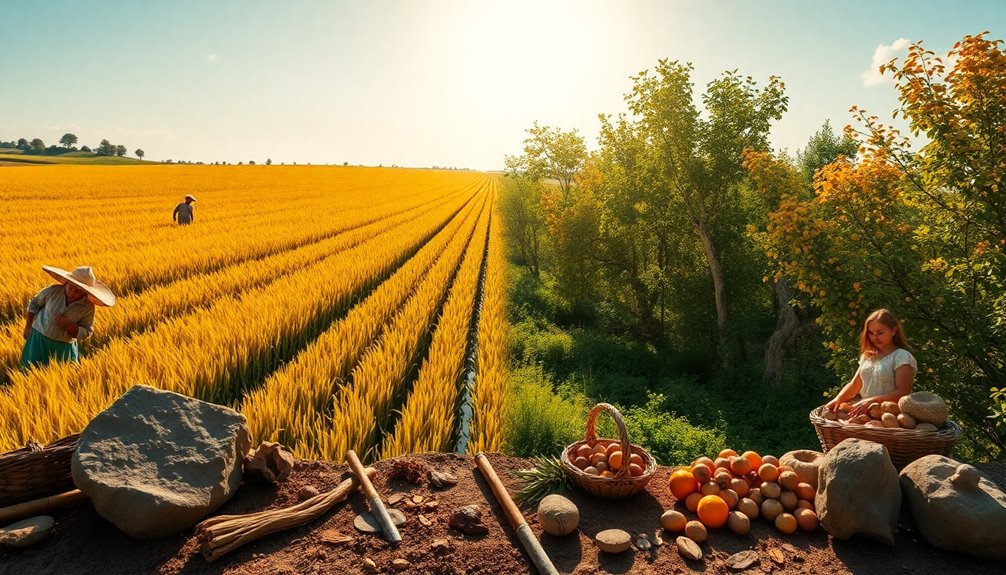
As you explore the rise of farming, you'll notice its significant advantages over foraging, like increased food production and the ability to support larger communities.
This shift not only fostered permanent settlements but also led to new social structures and roles.
However, it's crucial to compare these benefits with the flexibility and sustainability of a foraging lifestyle. Furthermore, foragers often relied on non-perishable items to supplement their diets during lean seasons, showcasing a diverse approach to food sourcing.
Agricultural Advantages Explored
The rise of farming during the Neolithic Revolution around 10,000 BC marked a pivotal shift in human history, ushering in an era of increased food production and the establishment of permanent settlements. As you explore this change to agriculture, you'll notice how farming communities began to flourish, spreading across Europe between 8,500 and 4,000 years ago. This shift also led to an increased reliance on renewable resources as communities sought sustainable ways to support their growing populations. In many cases, these communities also developed best outdoor survival bags to help manage their resources more effectively during seasonal changes. Beekeeping practices also began to emerge as a means to enhance food production and resource management. The adoption of farming techniques, similar to commercial grade heat pumps, allowed for more efficient use of land and resources.
This shift transformed social structures, moving people away from their nomadic lifestyles as hunters and gatherers to more fixed, organized societies.
With farming came the introduction of property rights, allowing individuals to claim ownership over land and resources. This notion of ownership contributed to social hierarchies and economic inequality that characterized early agricultural societies.
While the increased food production seemed advantageous, early farmers faced challenges such as low yields and high risks. In contrast, foraging societies often demonstrated resilience and maintained healthier lifestyles with less labor-intensive work.
It's essential to recognize that the adoption of farming wasn't instantaneous. Instead, it was a gradual process influenced by environmental changes and social factors, often blending elements of both foraging and agriculture for millennia. Moreover, the transition to agriculture also sparked developments in renewable energy sources that would transform energy use in later societies.
Foraging Lifestyle Comparisons
Hunter-gatherer societies thrived on a foraging lifestyle that offered distinct advantages over early agricultural practices. Foragers enjoyed a more varied diet, leading to lower disease rates compared to farming communities. You'd find that foraging required less energy to obtain food, allowing for a balanced work-life dynamic and less strenuous daily routines. This efficiency made life less burdensome than the demanding schedules of early agriculture.
Moreover, foraging societies displayed greater social equality, as resources were shared more evenly among community members. In contrast, agriculture often gave rise to hierarchies and disparities in wealth, altering social dynamics considerably. The shift to sedentary lifestyles brought about by farming also presented challenges, as close living quarters increased the spread of diseases and restricted mobility.
Foragers proved to be resilient to environmental shocks, adopting sustainable resource management practices that farming communities struggled to match. As you consider these comparisons, it becomes clear that while agriculture may have allowed for population growth, foraging provided a more egalitarian and adaptable way of life that many early societies thrived on.
In the end, the choice between foraging and agriculture shaped the development of human civilization in profound ways.
Impact on Social Structures
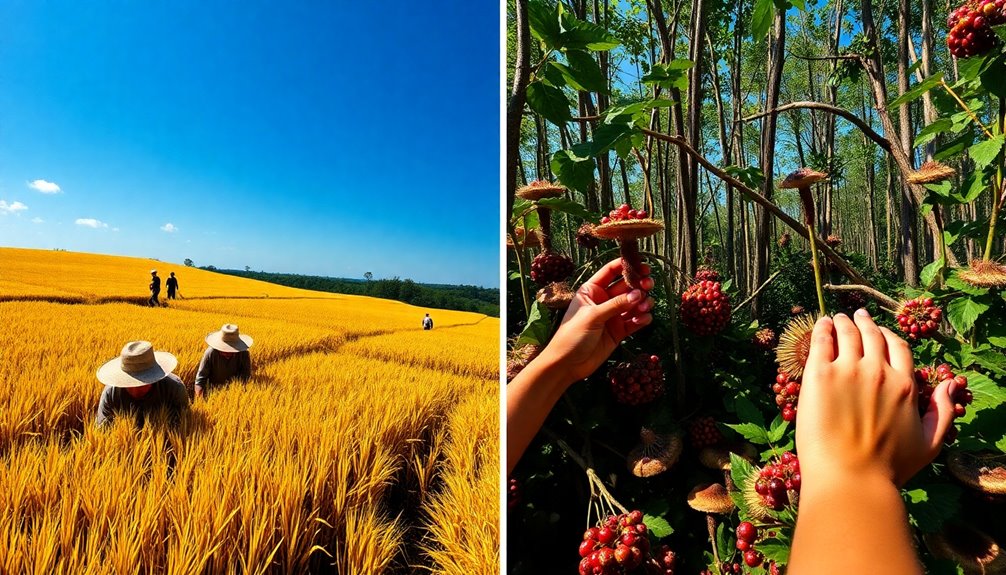
When you consider the shift to farming, you can't ignore how it changed social structures.
Fixed communities led to social hierarchies, as people specialized in different roles, creating new dynamics in labor and relationships.
This shift not only affected community organization but also introduced economic disparities that were less prevalent in foraging societies.
Social Hierarchies Emergence
Emerging from the shift to farming, social hierarchies began to reshape community dynamics markedly. As communities settled into fixed locations, the concept of resource ownership gained prominence. This shift led to individuals occupying specialized roles within society, which in turn fostered wealth disparities and social stratification. Furthermore, the development of executive function skills among leaders allowed for more effective governance and resource management.
Here's a snapshot of how these changes impacted ancient communities:
| Social Role | Resource Ownership | Wealth Disparity |
|---|---|---|
| Farmers | Land and crops | High |
| Leaders | Tools and livestock | Very high |
| Artisans | Crafts and goods | Moderate |
| Laborers | Basic necessities | Low |
| Outcasts | Minimal resources | Very low |
As seen in archaeological evidence from sites like Tell Halula in Syria, household autonomy and defined social segments emerged, contrasting sharply with the egalitarian structures of foraging societies. The increase in food production not only spurred population growth but also entrenched leadership roles, solidifying these newly formed social hierarchies. Unfortunately, close living conditions also led to health disparities, further entrenching inequalities among different social classes. Additionally, the rise of specialized roles in farming communities often resulted in the development of new tools and techniques that further supported these social structures.
Labor Specialization Effects
Labor specialization had a profound impact on social structures in early agricultural societies. As communities shifted to farming, individuals began focusing on specific tasks like tool-making, pottery, and trade. This change not only enhanced productivity but also allowed for the emergence of social hierarchies.
In agricultural settlements, you'd notice distinct roles between farmers, artisans, and leaders, which contributed to a more complex social fabric. With labor specialization, surplus food production became a reality. This surplus enabled communities to trade goods, leading to the development of intricate economic systems.
Unlike the more egalitarian structures of foraging societies, the fixed nature of agricultural settlements fostered greater social organization. You could see clear roles and responsibilities within these communities, further solidifying social hierarchies.
Archaeological evidence from sites like Çatalhöyük and Tell Halula showcases this social differentiation and the complex community organization that arose from labor specialization.
Fundamentally, the shift to farming not only changed how people worked but also reshaped the very foundations of society, paving the way for new social dynamics and relationships.
Environmental Influences on Agriculture

Throughout history, environmental changes have markedly shaped agricultural practices. As the last Ice Age ended, warmer and wetter conditions emerged, paving the way for farming around 10,000 BC. In regions like the Levant and the Fertile Crescent, wild grains flourished, igniting the shift from foraging to Neolithic agriculture.
You can see this transformation in the rise of agricultural communities that sprang up near river valleys like the Nile, Tigris, and Euphrates, where fertile soil and reliable water sources thrived. The adoption of solar-powered irrigation systems allowed these communities to enhance crop yields and efficiency, further solidifying their agricultural practices. This shift towards farming also contributed to the deforestation and habitat destruction that often accompanies agricultural expansion, impacting local ecosystems. Additionally, the practice of using wood-burning stoves for heating in these regions provided a sustainable energy source that complemented agricultural activities.
As populations grew, the pressure on local resources intensified, leading societies to adopt farming as a more sustainable food production method. This shift was largely a response to environmental constraints.
The theory of niche construction offers insight into how these early agriculturalists actively modified their surroundings. Through practices like irrigation and soil management, they not only adapted to their environments but also shaped them, facilitating further agricultural development. Additionally, the adoption of energy-efficient technology in agriculture has contributed to more sustainable practices and resource management.
These environmental influences were vital in defining the path of human civilization, marking a significant departure from the foraging lifestyle and establishing the foundations for future agricultural practices.
Health Comparisons: Foragers vs. Farmers
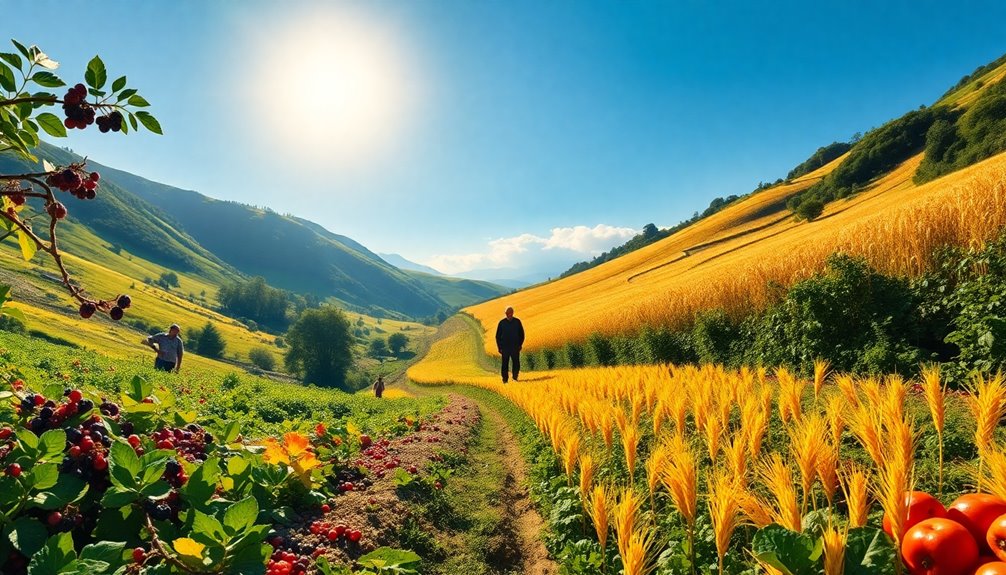
Many people might be surprised to learn that foragers generally enjoyed better health compared to early farmers. The diverse diets of foragers provided superior nutrition, while farmers often faced deficiencies due to their reliance on staple crops.
Here are some key health comparisons:
- Diet Diversity: Foragers consumed a wide range of foods, enhancing their nutritional balance.
- Chronic Disease Rates: Hunter-gatherers showed lower rates of obesity and diabetes, thanks to their active lifestyles.
- Height and Health Decline: The change to farming coincided with a drop in average height and health markers, as farmers dealt with malnutrition and increased pathogens.
- Sedentary Lifestyle Risks: Farming led to sedentary living, higher population density, and a greater spread of infectious diseases, unlike the mobile foraging lifestyle.
In essence, foragers typically enjoyed a healthier existence, largely due to their varied diets and active way of life.
As evidence suggests, the change to agriculture brought about significant health challenges. Understanding these differences helps clarify why many still debate the merits of foraging versus farming today.
Perspectives From Comics
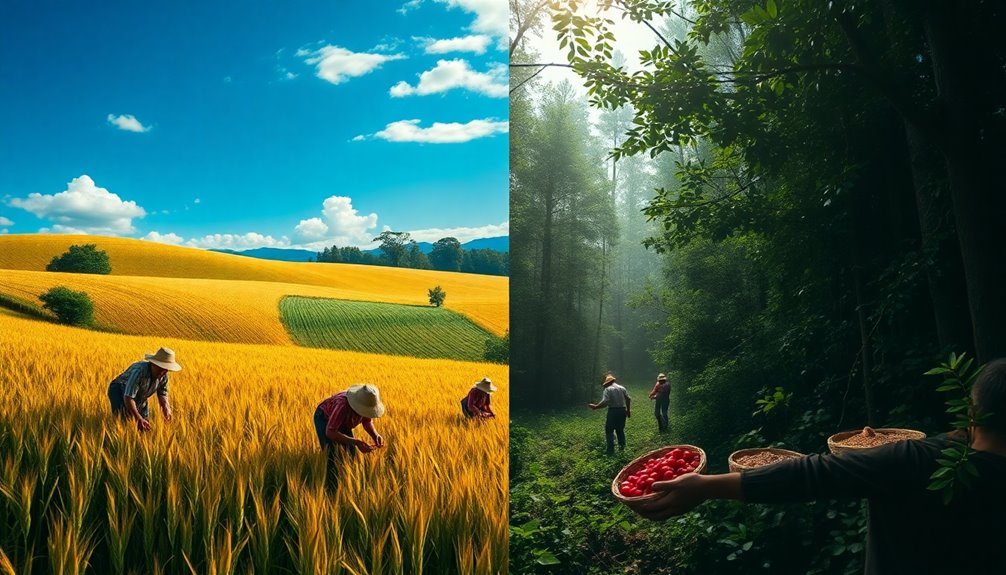
Comics offer a unique lens through which to explore the farming versus foraging debate, often presenting contrasting perspectives that engage readers. For instance, "Join the Neolithic Revolution!" highlights how farming made food production more efficient, enabling larger communities to thrive. This narrative emphasizes the perceived benefits of agriculture, suggesting a straightforward progression from foraging societies to settled farming life.
In contrast, "Why farm?" challenges this viewpoint by questioning the advantages of agriculture. It points out the health problems that arose with farming, including malnutrition and disease, while praising the sustainability of foraging societies. This comic encourages you to reflect critically about the costs of agricultural expansion, such as social inequality and the environmental impact.
Using comics in education makes the complexities of the Neolithic Revolution more accessible and engaging for students. The visual storytelling stimulates discussion and promotes deeper understanding.
Classroom Engagement Strategies
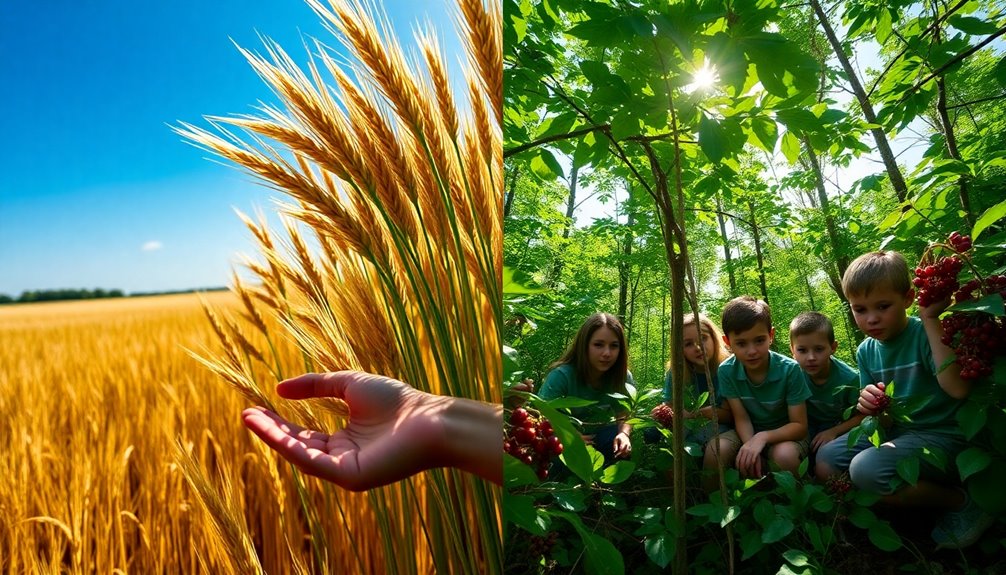
Exploring the farming versus foraging debate through engaging activities can greatly enhance student understanding and participation. By implementing effective classroom engagement strategies, you can foster critical thinking and encourage students to analyze historical narratives from various perspectives.
Here are four engaging methods you can use:
- Side-by-Side Comparison Tables: Have students visually assess the advantages and disadvantages of farming versus foraging. This visual assessment will help them grasp the complexities of each lifestyle.
- Comics and Illustrations: Utilize comics like "Join the Neolithic Revolution!" to make complex ideas more accessible. These engaging materials can spark interest and improve retention.
- Online Discussions and Group Projects: Encourage creativity and peer-to-peer interaction through non-traditional formats. These collaborative activities can lead to a more dynamic classroom environment and promote deeper understanding.
- Structured Analysis Activities: Implement tasks like "What Do You Think?" that empower students to take a stance and defend their views, thereby enhancing their argumentative skills.
Evaluating Information Validity
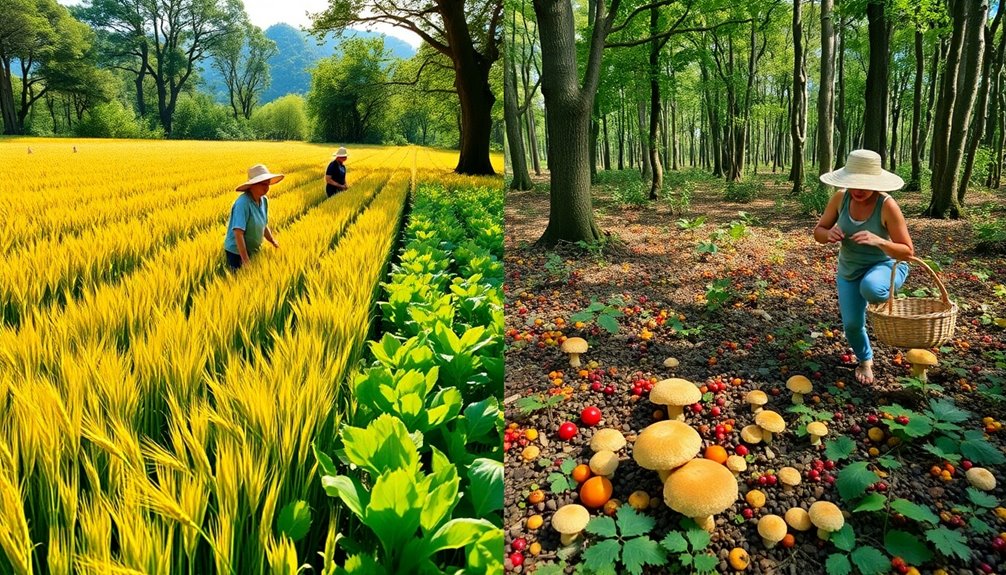
Given the abundance of information available today, evaluating the validity of sources has become essential for understanding complex topics like the farming versus foraging debate.
It's vital to determine whether farming was a good or bad choice for the history of humanity. Engaging with diverse formats, such as comics, can help you assess the credibility of information effectively.
Comics present historical narratives in a simplified, engaging manner, allowing for better retention and critical evaluation. When you contrast the benefits of farming with those of foraging through visual storytelling, you can uncover the nuances behind each perspective.
This approach encourages deeper engagement and promotes critical thinking about what you read. As you analyze various sources, remember to evaluate their reliability.
Are the facts presented backed by evidence? Do they come from credible experts or reputable studies? By applying this critical lens, you'll gain a more thorough understanding of the farming versus foraging debate.
Ultimately, your ability to evaluate information validity will enhance your grasp of these historical practices and their implications for our understanding of humanity's development.
Frequently Asked Questions
What Was Better, Farming or Foraging?
When you think about whether farming or foraging was better, consider the benefits and challenges each lifestyle offered.
Foraging provided a diverse diet and required less labor, while farming allowed for stable communities and food surpluses.
However, farming often brought health issues and social inequalities.
Ultimately, the choice depended on environmental conditions and personal circumstances.
You might find that each method has its own merits and drawbacks, making it hard to declare one superior.
What Effect Did Farming Have on Ancient Civilizations?
Farming's like planting the seeds of civilization, transforming scattered tribes into bustling communities.
You see, it sparked a revolution, boosting food production and allowing people to settle down. As harvests flourished, so did social hierarchies, with roles blossoming like wildflowers in spring.
Yet, living close together brought challenges, like disease spreading faster than gossip.
Ultimately, farming laid the groundwork for urban centers, shaping the tapestry of ancient civilizations and their complex societies.
Why Did We Switch From Foraging to Farming?
You switched from foraging to farming primarily due to necessity. As populations grew and resources became scarce, communities sought more reliable food sources.
Environmental changes made farming a viable option, allowing you to cultivate crops and domesticate animals. This gradual shift wasn't instantaneous; many continued to forage while adopting agricultural practices.
Social dynamics also played a role, as competition for resources led to the establishment of property rights and new hierarchies within communities.
Why Is Farming Better Than Hunter-Gatherers?
Imagine a world where one farmer can feed up to 100 people with just a few acres of land.
Farming's stability means you don't have to constantly move in search of food like hunter-gatherers. You can cultivate crops and domesticate animals, leading to larger, permanent settlements.
This stability fosters population growth, specialization, and trade, enabling complex societies to thrive.
In short, farming creates a sustainable lifestyle that supports bigger communities and advances civilization.
Conclusion
So, you think farming is the clear winner over foraging, huh? Ironically, while farmers cultivated the land and built civilizations, they also laid the groundwork for social hierarchies and health issues. Foragers, on the other hand, thrived in a world of abundance and equality, yet they're often seen as primitive. In the end, maybe it's not about which is better, but rather how each shaped humanity in ways we're still grappling with today.


